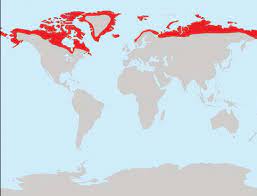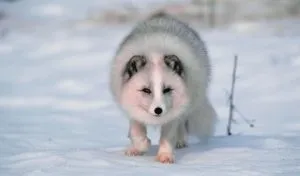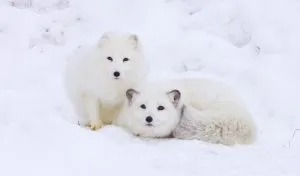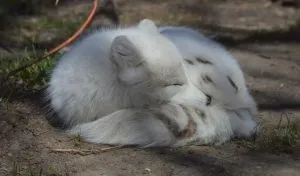Arctic foxes are known for their white fur coat that helps them blend in with their snowy surroundings. But where do they live?
There are approximately 630,000 arctic foxes left although estimates do vary by several hundred thousand. They live in the arctic and alpine tundra found in the northernmost parts of the world, including Alaska, Canada, Greenland, Iceland, Russia, and Fennoscandia.
Keep reading for a full breakdown of the estimated numbers in each region along with the origin of the arctic fox and the different types.
Where Do Arctic Foxes Live?
Arctic foxes live in the arctic tundra which is found in the northern hemisphere from the north pole, extending south. This includes parts of Alaska, Canada, Greenland, Iceland, Russia, and Scandinavia1 (source: IUCN).
They can also be found in nearby alpine tundra which are high-altitude areas with a similar climate to the arctic. Arctic foxes can be found in the alpine tundra of Finland and Scandinavia (often called Fennoscandia)2 (source: The Dynamics of Canadian Arctic Fox Populations, A. H. Macpherson, 1969).
This map from IUCN gives a good approximation of the geographical range of arctic foxes:
How Many Arctic Foxes Are Left?
There are estimated to be about 630,000 arctic foxes left in the world. However, there are several areas where the population numbers have not been studied closely, so the figure could be as low as 330,000 or as high as 930,0003 (source: IUCN Canid Specialist Group, C. Sillero-Zubiri, M. Hoffmann, and D. W. Macdonald, 2004).
This table gives a breakdown of the estimated arctic fox population in each region:
| Region | Approximate Number |
|---|---|
| Canada | 100,000 |
| USA (coastal Alaska) | 10,000 |
| Greenland | > 10,000 |
| Russia (mainland) | 200,00 – 800,000 |
| Russia (Mednyi Island) | 100 |
| Russia (Bering Island) | 800 – 1,000 |
| Iceland | > 6,000 |
| Finland | 20 |
| Norway (mainland) | 50 |
| Norway (Svalbard) | 2,000 – 3,000 |
| Sweden | 50 |
| Total | 330,000 – 930,000 (Average: 630,000) |
As you can see, there are several areas where arctic foxes are at risk of becoming endangered, with populations below 100 in many parts of Fennoscandia.
Find out more about the reasons behind this in our full article on why arctic foxes are becoming endangered.
Inland vs Coastal Arctic Foxes
Arctic foxes can be split into two main populations, those that live inland and those that live in coastal areas4 (source: The Arctic Fox: An Opportunistic Specialist, B. Elmhagen. et al, Journal of Zoology Vol 251, Issue 2, 2006).
The main difference between the two populations is what they eat. Arctic foxes who live inland tend to rely on small rodents such as lemming, whereas those that live in coastal areas eat seabirds, fish, and other marine invertebrates.
However, arctic foxes are opportunistic omnivores, which means they will eat anything they can get their paws on including seaweed, berries, carcasses, or feces of other animals.
Those that live inland and rely on lemmings have a less stable food supply as the lemming population usually peaks every 3-5 years but can be scarce in-between.
Inland arctic foxes adjust their reproductive cycles to try and have the majority of their offspring during peak lemming years when food is abundant. They will often have large litters of up to 18 during these years5 (source: Fluctuating Resources and the Evolution of Litter Size in the Arctic Fox, M. Tannerfeldt and A. Angerbjörn Oikos, Vol. 83, No. 3).
By contrast, coastal arctic fox populations have a more stable food supply from year to year so tend to reproduce smaller litters but more frequently.
Most arctic foxes change color in winter when they grow a thick white fur coat to blend in with the snow, they then shed this for a lighter brown or grey coat in summer6 (source: National Geographic).
However, there is a rare blue morph arctic fox which can often be spotted in coastal areas of Greenland and Iceland7 (source: Journal of Animal Ecology, C.D. Bernardi, Volume 90, Issue 5, 2021). They do not grow a thick white coat in winter like the white morph, instead, they have a dark gray/blue coat in summer and a lighter gray coat in winter.
Where Do Arctic Foxes Come From?
It is thought that arctic foxes originally evolved in Europe during the ice age that occurred 2.6 million years ago. They have since colonized many other regions of the arctic tundra including Alaska, Canada, and Greenland.
Arctic foxes use moving sea ice as a way of getting between continents. Mini ice ages have helped arctic foxes expand their geographical range, as temperatures warm, they become isolated and begin colonizing new areas8 (source: Biological Journal of the Linnean Society, L. Dalen. et al, Vol 84, Issue 1, 2005).
An extreme example of this is Iceland where arctic foxes are the only native land mammal. They traveled to Iceland by sea ice from Russia, Alaska, and Canada during a mini ice age around 200-500 years ago. However, temperatures warmed and the sea ice melted which left them isolated in Iceland9 (source: Durham University, 2012).
Arctic foxes still use sea ice for migrating today. In 2017, one blue arctic fox was tracked migrating 3,500km from Norway to Canada in 76 days10 (source: The Guardian, 2019). More on migration habits below.
Where Do Arctic Foxes Live in the Summer?
The majority of arctic foxes do not migrate, they spend both summer and winter in the arctic tundra. They adapt well to the winter climate by growing a thick white fur coat and building snow lairs or dens below the snow for shelter11 (source: Adaptations by the Arctic Fox to the Polar Winter, Arctic, Vol 44, Issue 2, 1991).
When food is in short supply, they will take short 1-3 day commuter trips to nearby sea ice to find food. This is usually in the form of seal carcasses left behind by polar bears.
A small proportion (less than 5%) of arctic foxes do migrate. For example, those that live in the inland areas of Iceland will migrate to coastal areas where the food supply of seabirds and fish are more abundant than their usual summer diet of lemmings.
Related Questions
Do Arctic Foxes Live in Antarctica?
No, arctic foxes are found near the north pole, in the arctic tundra, and some nearby alpine tundra. They are not found in Antarctica which is the continent at the south pole. There are no naturally occurring land mammals in Antarctica12 (source: British Antarctic Survey).
Do Arctic Foxes Live in Packs?
Yes, arctic foxes live in packs, although the correct term for a group of foxes is a skulk. Arctic foxes are usually monogamous which means they pair to breed and raise their offspring.
Some arctic foxes live as a single breeding pair, whereas others will live in larger groups. This is often determined by the amount of food available and the number of predators13 (source: Canadian Journal of Zoology, Norén et al, Vol. 90, 2012).
When living in a group, they can better defend against predators, however, they must also share resources. This is the trade-off they must make and in regions with scarce food, it is often better for them to live as a single breeding pair than a large group.
Where Do Arctic Foxes Live in Canada?
Arctic foxes live in the arctic tundra which covers about 26% of Canada’s landmass14 (source: Wikipedia). This includes Yukon, the Northwest Territories, and Nunavut, as well as the northernmost parts of Manitoba, Ontario, Quebec, and Labrador.
Arctic foxes can also be found on the Arctic Archipelago, a group of Canadian islands which lies north of the mainland.






